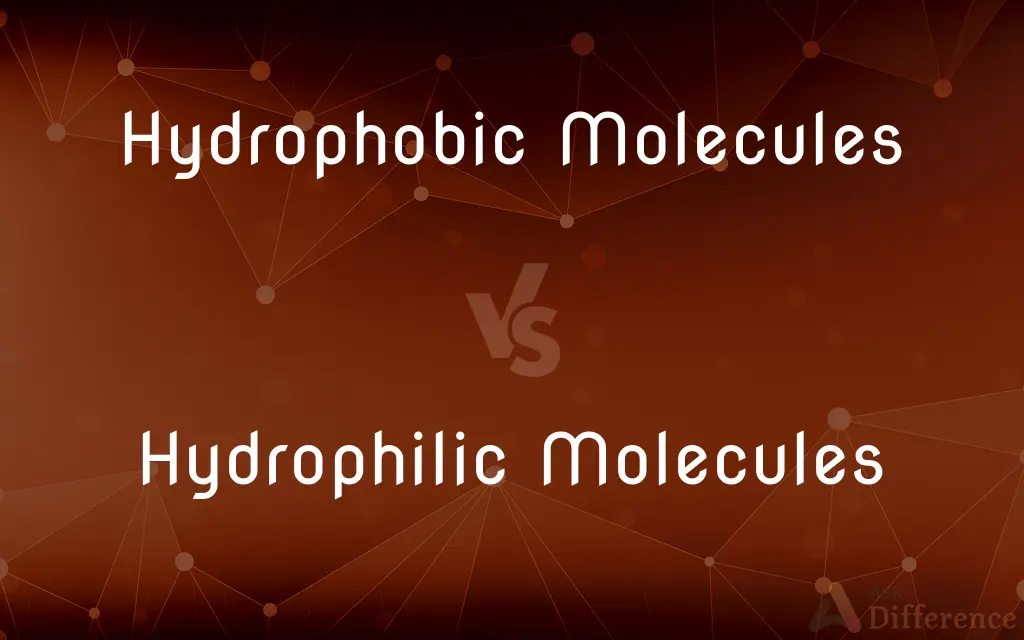Hydrophobic Molecules vs. Hydrophilic Molecules — What's the Difference?
Edited by Tayyaba Rehman — By Fiza Rafique — Published on December 2, 2023
Hydrophobic molecules repel water, while hydrophilic molecules attract and interact with water.

Difference Between Hydrophobic Molecules and Hydrophilic Molecules
Table of Contents
ADVERTISEMENT
Key Differences
Hydrophobic molecules, by definition, are molecules that exhibit a lack of affinity toward water. This aversion arises from the nonpolar nature of these molecules. When exposed to water, they tend to cluster together, minimizing their contact with the water molecules, as observed in oil droplets merging in water.
Hydrophilic molecules, conversely, have a strong affinity for water and readily interact with it. These molecules are typically polar, meaning they have areas of positive and negative charge. This polar nature enables them to form hydrogen bonds with water, leading to their solubility in it, as seen with sugar dissolving in water.
A clear example showcasing the behavior of hydrophobic molecules and hydrophilic molecules is a cell membrane. The cell membrane contains phospholipids, molecules with a hydrophilic "head" and two hydrophobic "tails". The hydrophilic heads face outwards, interacting with the surrounding water, while the hydrophobic tails are oriented inwards, avoiding water contact.
The behavior of hydrophilic and hydrophobic molecules plays a crucial role in numerous biological processes and chemical reactions. Enzymes, for instance, have hydrophilic and hydrophobic regions that determine their interactions with other molecules, influencing their activity.
In essence, the primary distinction between hydrophobic and hydrophilic molecules lies in their relationship with water. While hydrophobic molecules repel water due to their nonpolar nature, hydrophilic molecules readily associate with water because of their polar characteristics.
ADVERTISEMENT
Comparison Chart
Affinity to Water
Repels water
Attracts water
Molecular Nature
Nonpolar
Polar
Solubility in Water
Insoluble
Soluble
Interaction in Aqueous Solution
Forms separate phase/clusters
Dissolves/interacts
Examples
Oils, fats
Sugars, salts
Compare with Definitions
Hydrophobic Molecules
Molecules lacking charged regions to interact with water.
Waxes, being hydrophobic, bead up when in contact with water.
Hydrophilic Molecules
Molecules that readily associate with water.
Salt dissolves in water due to its hydrophilic properties.
Hydrophobic Molecules
Substances that resist dissolution in water.
Butter, being hydrophobic, does not dissolve in water.
Hydrophilic Molecules
Compounds that mix with water.
Ethanol is hydrophilic and blends seamlessly with water.
Hydrophobic Molecules
Compounds that segregate from water.
Nonpolar solvents like hexane are hydrophobic and separate from water.
Hydrophilic Molecules
Substances that dissolve in water.
Glucose, being hydrophilic, easily dissolves in water.
Hydrophobic Molecules
Molecules that repel water.
Oil does not mix with water due to its hydrophobic nature.
Hydrophilic Molecules
Molecules with charged regions allowing water interaction.
Amino acids have hydrophilic portions enabling them to interact with water.
Hydrophobic Molecules
Nonpolar compounds avoiding aqueous environments.
The inner core of a cell membrane comprises hydrophobic molecules.
Hydrophilic Molecules
Polar compounds interacting strongly with aqueous environments.
The outer layer of a soap molecule is hydrophilic and attracts water.
Common Curiosities
What are hydrophobic molecules?
Hydrophobic molecules are compounds that repel water.
Can hydrophilic molecules form hydrogen bonds with water?
Yes, their polar nature allows them to form hydrogen bonds with water.
How do detergents work with both types of molecules?
Detergents have hydrophilic heads and hydrophobic tails, bridging water and grease.
Why don't hydrophobic molecules dissolve in water?
Their nonpolar nature prevents interaction with polar water molecules.
How do hydrophobic molecules behave in water?
They tend to cluster together, avoiding interaction with water.
Are lipids typically hydrophilic or hydrophobic?
Lipids are typically hydrophobic, repelling water.
Can a molecule have both hydrophobic and hydrophilic regions?
Yes, such as in phospholipids which have a hydrophilic head and hydrophobic tails.
What characterizes hydrophilic molecules?
Hydrophilic molecules attract and readily interact with water.
Why are some proteins both hydrophilic and hydrophobic?
Proteins have diverse regions, allowing them to interact with and repel water at different sites.
Are sugars considered hydrophilic or hydrophobic?
Sugars are hydrophilic because they dissolve in water.
Share Your Discovery

Previous Comparison
Paneer vs. Mozzarella Cheese
Next Comparison
Primary Active Transport vs. Secondary Active TransportAuthor Spotlight
Written by
Fiza RafiqueFiza Rafique is a skilled content writer at AskDifference.com, where she meticulously refines and enhances written pieces. Drawing from her vast editorial expertise, Fiza ensures clarity, accuracy, and precision in every article. Passionate about language, she continually seeks to elevate the quality of content for readers worldwide.
Edited by
Tayyaba RehmanTayyaba Rehman is a distinguished writer, currently serving as a primary contributor to askdifference.com. As a researcher in semantics and etymology, Tayyaba's passion for the complexity of languages and their distinctions has found a perfect home on the platform. Tayyaba delves into the intricacies of language, distinguishing between commonly confused words and phrases, thereby providing clarity for readers worldwide.
















































